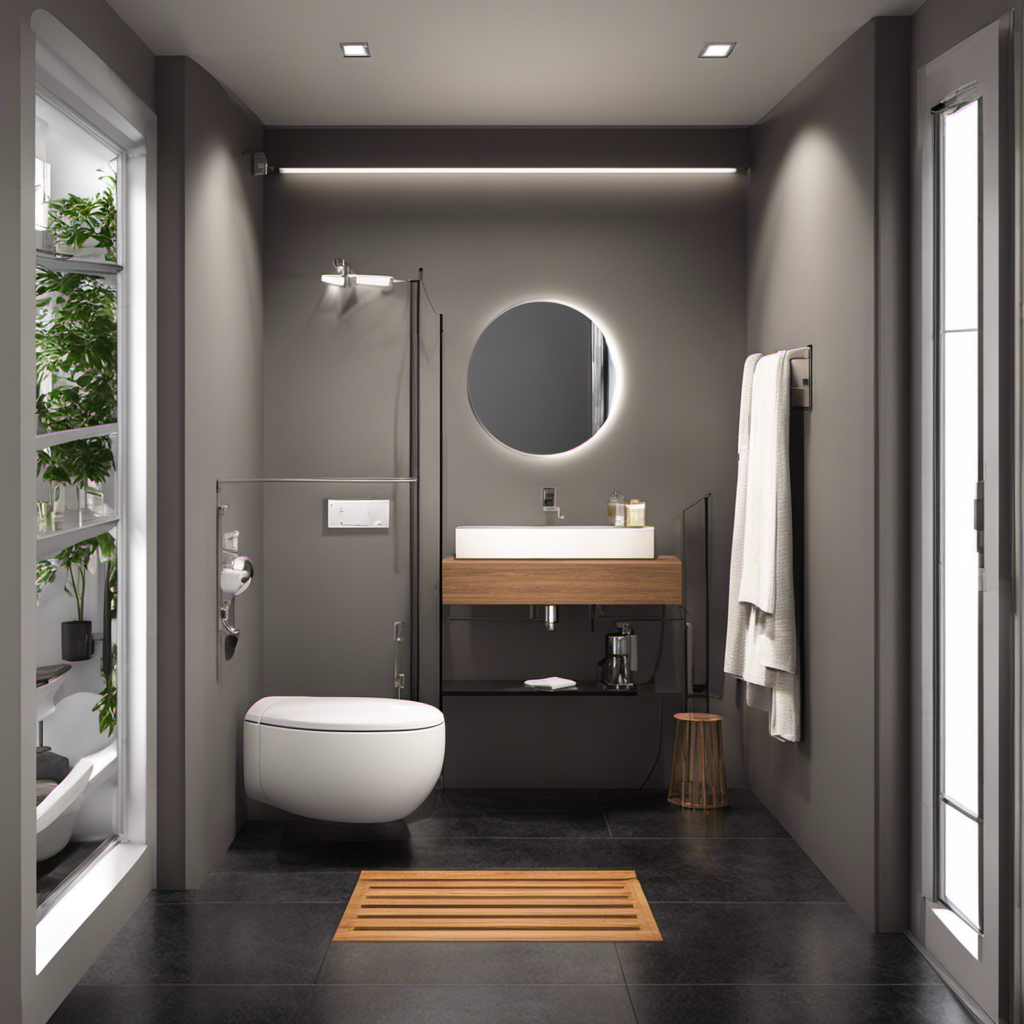When it comes to choosing the right vent size for your toilet, making the correct decision is crucial.
Imagine this scenario: you’ve just installed a new toilet in your bathroom, but you start experiencing unpleasant odors and slow drainage. What went wrong? The answer could lie in the size of your toilet vent.
In this article, I will guide you through the factors to consider when selecting a vent size, explain the importance of proper ventilation, and offer troubleshooting tips for common ventilation issues in toilet systems.
Key Takeaways
- The most common vent sizes for toilets are 2 inches and 3 inches.
- The size of the toilet and the number of fixtures connected to the vent are important factors to consider when choosing a vent size.
- Proper venting is crucial for maintaining the plumbing system’s integrity and efficient waste flow.
- Always consult local plumbing codes for vent size compliance to ensure proper toilet functioning and a healthy bathroom environment.
Common Vent Sizes for Toilets
The most common vent sizes for toilets are 2 inches and 3 inches. When it comes to toilet vent installation, the vent pipe diameter plays a crucial role in ensuring proper ventilation and preventing clogs or odors.
The vent pipe allows air to flow into the plumbing system, balancing the pressure and allowing waste to flow smoothly down the drain. A 2-inch vent pipe is typically used for residential toilets and is suitable for most standard installations. However, in larger buildings or commercial settings where there may be multiple toilets connected to a single vent stack, a 3-inch vent pipe may be required to handle the increased volume of waste.
Factors to consider when choosing a vent size include the number of toilets being connected and the overall layout of the plumbing system.
Factors to Consider When Choosing a Vent Size
When choosing the right vent, you should consider factors such as the distance between the toilet and the main stack. Proper installation of the vent is crucial to ensure proper functioning of the toilet and to prevent any potential issues down the line.
Here are three important factors to consider when choosing a vent size:
-
Size of the toilet: The size of the vent should be proportional to the size of the toilet. Larger toilets may require larger vents to ensure adequate airflow and proper waste removal.
-
Number of fixtures: If you have multiple fixtures connected to the same vent, such as other toilets or sinks, you need to take into account the total volume of waste that will be flowing through the vent. A larger vent may be necessary to handle the increased load.
-
Vertical distance: The vertical distance between the toilet and the main stack is another important factor. The greater the distance, the more pressure the vent will need to handle in order to properly remove waste. A vent that is too small may lead to clogs and backups.
Considering these factors and ensuring proper installation will help you choose the right vent size for your toilet, ensuring optimal performance and preventing any potential issues in the future.
Understanding Vent Pipe Sizing for Toilets
To properly understand the vent pipe sizing for your toilets, you should take into account factors like the distance between the toilet and the main stack. Following the toilet venting code is crucial for ensuring proper ventilation and avoiding potential plumbing issues.
Proper venting plays a vital role in maintaining the integrity of your plumbing system and ensuring the efficient flow of waste and air. It helps to prevent sewer gases from entering your home, eliminates the risk of siphoning water from traps, and reduces the chances of clogs and backups.
Recommended Vent Sizes for Different Toilet Installations
For different toilet installations, it’s important to consider the recommended sizes for vents. Toilet venting regulations outline specific guidelines for vent sizes based on factors such as the number of fixtures connected to the vent and the distance between the toilet and the vent stack.
When choosing the right vent size for your bathroom, there are a few key considerations to keep in mind:
-
Fixture Units: The vent size should be based on the total number of fixture units connected to the vent. This helps ensure proper airflow and prevents the buildup of sewer gases.
-
Distance: The distance between the toilet and the vent stack plays a crucial role in determining the vent size. Longer distances may require larger diameter vents to maintain adequate ventilation.
-
Local Codes: Always consult your local plumbing codes to ensure compliance with specific regulations regarding vent sizes.
Choosing the correct vent size is vital for the proper functioning of your toilet and maintaining a healthy bathroom environment.
Now, let’s explore the importance of proper ventilation for toilets.
Importance of Proper Ventilation for Toilets
Proper ventilation is crucial for toilets as it serves multiple purposes.
Firstly, ventilation helps prevent odors from lingering in the bathroom, ensuring a more pleasant and comfortable environment.
Secondly, it plays a vital role in preventing the growth of mold and mildew, which can be harmful to both the structure of the bathroom and the health of its occupants.
Lastly, a well-ventilated toilet helps to maintain proper humidity levels, reducing the risk of condensation and water damage.
Ventilation Prevents Odors
Ventilation helps eliminate unpleasant odors. As an expert in toilet ventilation systems, I understand the benefits of proper ventilation in preventing these odors from lingering in your bathroom.
Here are three reasons why ventilation is crucial for maintaining a fresh and odor-free environment:
-
Removal of moisture: Proper ventilation removes excess moisture from the air, preventing the growth of mold and mildew, which can contribute to unpleasant odors.
-
Air circulation: Ventilation systems ensure proper air circulation, which helps to disperse odors and prevent them from settling in one area.
-
Improved indoor air quality: By constantly exchanging stale air with fresh air from outside, ventilation systems help remove odors and improve the overall indoor air quality, providing a healthier and more comfortable environment.
Investing in a quality toilet ventilation system will not only eliminate odors but also contribute to a more pleasant and hygienic bathroom experience.
Avoid Mold and Mildew
By regularly using a ventilated bathroom, you can prevent the growth of mold and mildew. Proper ventilation is crucial in preventing moisture buildup, which is the main cause of mold and mildew formation.
Mold and mildew thrive in damp environments, and bathrooms are particularly susceptible due to the high levels of humidity generated from showers, baths, and sinks. Ventilation benefits include the removal of excess moisture, preventing condensation on walls and surfaces, and improving air quality by reducing the concentration of mold spores and other allergens.
A well-ventilated bathroom can also help eliminate unpleasant odors and create a more comfortable and healthier environment. To effectively prevent mold and mildew, ensure your bathroom has proper ventilation in the form of exhaust fans, windows, or other ventilation systems.
Troubleshooting Ventilation Issues in Toilet Systems
If you’re experiencing any issues with your toilet system, it’s important to troubleshoot the ventilation to ensure proper functionality. A properly installed toilet vent is crucial for preventing odors, maintaining air circulation, and preventing potential health hazards.
Here are three things to consider when troubleshooting toilet ventilation issues:
-
Check the vent installation: Ensure that the vent is correctly installed and free from any obstructions. A properly installed vent should be positioned vertically and extend above the roofline to allow for proper air flow.
-
Inspect the vent pipe: Examine the vent pipe for any damage or blockages. Debris or animal nests can obstruct the vent, leading to poor ventilation. Clear any obstructions and repair any damaged sections of the pipe.
-
Address toilet odors: If you’re experiencing persistent toilet odors, it could be a sign of a ventilation issue. Consider installing a carbon filter or an odor-neutralizing device to help eliminate unpleasant smells.
Frequently Asked Questions
How Does the Size of the Vent Affect the Overall Performance of a Toilet?
The size of the vent directly impacts the performance of a toilet. A properly sized vent allows for proper air flow, preventing common problems such as clogs and sewer gas backups. It’s essential to know how to install a toilet vent correctly to ensure optimal functionality.
Can a Toilet Function Properly Without a Vent Pipe?
A toilet may not function properly without a vent pipe. Proper toilet vent installation ensures proper drainage and prevents sewer gases from entering the bathroom. Troubleshooting toilet venting issues is crucial for maintaining a well-functioning plumbing system.
Are There Any Building Codes or Regulations That Dictate the Minimum Vent Size for Toilets?
There are building codes and regulations that dictate the minimum vent size for proper toilet ventilation. It is important to adhere to these minimum vent size regulations to ensure the toilet functions correctly.
What Are Some Signs That Indicate a Ventilation Issue in a Toilet System?
Signs of poor toilet ventilation include foul odors, slow draining, and gurgling sounds. Proper toilet venting is crucial to prevent sewer gases from entering the home and to ensure proper functioning of the plumbing system.
Can a Toilet Vent Be Shared With Other Plumbing Fixtures in a Residential or Commercial Building?
Yes, a toilet vent can be shared with other plumbing fixtures in a residential or commercial building. However, it is important to consider venting requirements for toilets in high rise buildings and the impact of shared venting systems on toilet performance.
Conclusion
In conclusion, choosing the right size vent for your toilet is absolutely crucial for optimal performance and functionality. The importance of proper ventilation cannot be overstated.
A small vent can lead to a buildup of unpleasant odors and even potential health hazards. On the other hand, an oversized vent can create a noisy and disruptive system.
So, make sure to carefully consider all the factors and recommended vent sizes for your specific toilet installation. Trust me, you don’t want to underestimate the power of a well-ventilated toilet!










